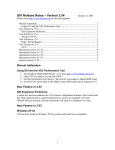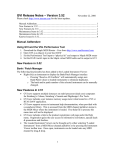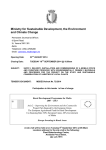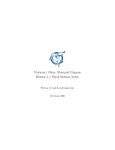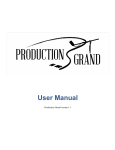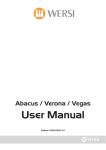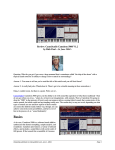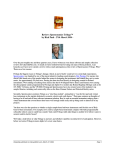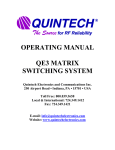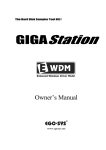Download Tascam GVI User's Manual
Transcript
Owner's Manual QuickEdit and GigaPulse Addendum 100206 CHAPTER 12: QUICKEDIT VIEW ........................................................................................................ 3 Instrument Select Drop-Down Menu.................................................................................................... 3 Undo/Redo ............................................................................................................................................ 3 EDIT MODES AND SELECTIONS.................................................................................................... 4 MIDI SELECT.................................................................................................................................. 4 EDIT MODE..................................................................................................................................... 5 KEYBOARD SELECT DROP-DOWN MENU .............................................................................. 5 DIMENSION SELECT DROP-DOWN MENU .............................................................................. 6 QUICKEDIT ARTICULATION TABS............................................................................................... 7 GVI GENERAL TAB....................................................................................................................... 7 VOLUME MODULATION SECTION............................................................................................ 8 VELOCITY RESPONSE SECTION................................................................................................ 8 INSTRUMENT GLOBAL SECTION............................................................................................ 11 GVI AMPLITUDE/PITCH TAB........................................................................................................ 11 AMPLITUDE ENVELOPE SECTION .......................................................................................... 12 PITCH ENVELOPE SECTION...................................................................................................... 13 AMP ENVELOPE MODULATION SECTION ............................................................................ 13 AMPLITUDE LFO SECTION ....................................................................................................... 14 PITCH LFO SECTION................................................................................................................... 15 GVI FILTER TAB .............................................................................................................................. 16 FILTER SECTION ......................................................................................................................... 16 FILTER ENVELOPE SECTION.................................................................................................... 18 MIDI CONTROL SECTION.......................................................................................................... 19 FILTER ENVELOPE MODULATION SECTION ....................................................................... 19 KEY RESPONSE SECTION ......................................................................................................... 19 FILTER LFO SECTION................................................................................................................. 20 GVI LOOP TAB ................................................................................................................................. 21 SAMPLE START SECTION ......................................................................................................... 21 LOOP SECTION ............................................................................................................................ 21 QUICKEDIT WAVEFORM VIEW ................................................................................................... 22 WAVEFORM VIEW ZOOM TOOLS ........................................................................................... 22 WAVEFORM DISPLAY WINDOW............................................................................................. 23 Envelope and LFO Selection: ......................................................................................................... 23 CHAPTER 13: GIGAPULSE VIEW...................................................................................................... 24 GIGAPULSE IN THE MIDI MIXER ................................................................................................ 25 OPENING THE GIGAPULSE UI.................................................................................................. 25 INPUT SECTION ........................................................................................................................... 26 ACOUSTIC SPACE SECTION ..................................................................................................... 26 MIC GROUP SECTION................................................................................................................. 27 MIC REPLACEMENT SECTION ................................................................................................. 30 MIC TO FX BUS ROUTING SECTION ....................................................................................... 33 2 CHAPTER 12: QUICKEDIT VIEW QuickEdit is a powerful tool that provides easy access to instrument/dimension specific synth parameters like attenuation, pan, tuning, envelopes, filters, LFO’s, and loop points. Edits made in QuickEdit are non-destructive, meaning they do not alter the original GIG files. Instead, instrument specific QuickEdit modifications are stored and recalled by saving either a preset or GSI file. The QuickEdit view can be opened using either the global EDIT button located on the GVI navigation toolbar or the green, channel specific EDIT buttons located on MIDI Mixer channel strips that contain loaded instruments. Instrument Select Drop-Down Menu Once in the QuickEdit View, it is possible to select any instrument currently attached to a MIDI channel or Stack Sub-channel using the QuickEdit instrument select drop-down menu. The menu is located just beneath the GVI File Management toolbar and above the waveform display. Only one instrument may be edited at a time. Undo/Redo GVI allows ninety-nine levels of Undo/Redo. The Undo/Redo buttons are located just above the Zoom Bar navigation buttons. 3 EDIT MODES AND SELECTIONS In a Giga instrument, every keyboard region has its own parameter settings for envelopes, LFOs, filters, and the like. The keyboard regions, each covering one or more keys, are displayed in the horizontal strip just above the virtual keyboard. You'll notice that one of the regions is always highlighted in bright yellow. This is the region whose parameters are displayed in the upper sections of the Editor. When you change a parameter, you'll be modifying this region plus any other regions highlighted in dim yellow. Keyboard regions are further subdivided into splits. For example, a piano might be sampled at 12 different velocity levels, yielding 12 velocity splits, each with its own audio sample and its own parameter settings. The same piano might have been sampled with the sustain pedal in both the up and down positions, for a total of 24 splits per region. In fact, if the samples are stereo, there are even separate parameter values for the left and right sides, making a total of 48 complete parameter sets per region. To show which split you are currently editing, the instrument's "dimensions" are displayed as horizontal strips just below the editing tabs. In the example above, you'd find three strips, for velocity, sustain pedal, and stereo. (This is only an example: every Giga instrument has its own structure.) One segment in each strip is highlighted in bright yellow to indicate the split whose parameters are currently on display. Again, when you change a parameter, you'll be editing this split plus any other splits highlighted in dim yellow (more about this below). Several buttons just above the keyboard influence how the selection process works: MIDI SELECT When this button is enabled (green), MIDI note on and controller messages will change the current region and split selections. This can be a convenient way of selecting a particular split for editing. But if you're playing a piece, you may want to disable this feature, to avoid a frenzy of screen updates which may tax your CPU. 4 EDIT MODE This affects how changes are applied when more than one region or split is selected for editing. Absolute: When you change a value in the QuickEdit, every selected (bright or dark yellow) region and split is set to exactly the value shown. If the selected regions were originally set to various unique values, they'll all be changed to the same value for any parameter that you edit. Relative: In this mode, every selected split is changed by an offset. For example, if you change and LFO rate from 4 Hz to 6 Hz, every selected split gets a 2 Hz increase. Proportional: This similar to Relative mode but uses multiplication rather than addition. If you change an LFO rate from 4 Hz to 6 Hz, every selected split gets a 50% increase. Note that if a relative or proportional edit tries to push a parameter outside its legal range, the parameter will be set to its minimum or maximum legal value. KEYBOARD SELECT DROP-DOWN MENU We noted above that a GVI instrument can contain a large number of regions, each subdivided into many independent splits. Often you will want to apply an edit globally across an entire instrument. At other times, you may need to edit only a particular region or group of regions. The "Keyboard Select" setting helps make either kind of editing possible. The options are: All regions: In this mode, all of the keyboard regions are locked into the selected state. Clicking on any keyboard region will make it the current region, highlighted in bright yellow. But all other regions will retain the dark yellow highlight, and any edits you make will always be applied to all regions across the keyboard. Individual regions: In this mode it's possible to select any set of keyboard regions you like. Click on a region to select that region. Click while holding down the CTRL key to add individual regions to the selection, or click with the SHIFT key to select a range of regions. Note that while this mode allows more detailed editing, it requires you to be aware of the region selection at all times. 5 DIMENSION SELECT DROP-DOWN MENU This is similar to the Keyboard Select menu, but it governs the selection of splits within each keyboard region, as displayed in the dimension strip area just below the editing tabs. The options are: All splits: Edits will always be applied to every split within a region. In the dimension selector strips, you can click any split to give it the bright yellow highlight and display its parameters. But all other splits will retain the dark yellow highlight, indicating that they will also be modified if you change a value. Stereo pairs: In this mode, splits can be selected in any combination. As an illustration, recall our piano instrument with the 24 splits per region (12 velocity levels times 2 sustain pedal positions). In "Stereo pairs" mode you could, for example, select only the three loudest velocity levels for editing, by highlighting the last three segments in the velocity strip. The sustain pedal strip would control whether you're editing the three loudest pedal-up splits, the three loudest pedal-down splits, or both (six splits in all). To select multiple splits in any dimension, click in that dimension strip while holding down the CTRL or SHIFT keys. Individual splits: When viewing a stereo instrument, you'll notice an additional dimension strip labeled Stereo". Stereo GVI instruments have independent parameter settings for the left and right sides of every split. In practice, it's rare to find any parameter set differently for the two sides of the same split, so edits are normally applied to both sides simultaneously. If you do need to apply an edit to only the left or right side of a region, "Individual splits" mode will let you do it. We suggest you use this mode only when you absolutely need to - otherwise you may find yourself applying more general edits accidentally to only one stereo channel. 6 QUICKEDIT ARTICULATION TABS GVI GENERAL TAB Volume: The Volume knob simply attenuates a region’s playback level between 0 and 98 decibels. A Volume value of 0.0 indicates that the region will play back un-attenuated. Pan: This setting sets the pan position by a value from -64 (hard left) to +63 (hard right). Tune: The Tune knob adjusts a region’s fine-tuning between – 49 and + 50 cents. Self-mask: When checked, this causes high velocity notes to terminate lower velocity voices. This feature conserves polyphony and should be tried on all samples with percussive attacks and releases (pianos, guitars, cymbals, etc.). Sustain Defeat: This setting enables or disables the sustaining action of the sustain pedal. This allows the sustain pedal to simply be used as a dimension switch without sustaining the samples. 7 VOLUME MODULATION SECTION Controller Drop-Down: This menu allows you to assign a MIDI continuous controller for real-time volume attenuation control. By assigning the same attenuation controller to groups of related notes or samples, a MIDI controlled sub mix capability can be designed into the instrument so that individual sounds can have discrete MIDI volume control. Attenuation Controller Invert: This option reverses the MIDI controller. This is necessary when creating a simple MIDI controller cross-fade layer. Both layers would be set to the same MIDI controller for attenuation but one would be inverted using this parameter. The result would be a cross-fade between both layers. Attenuation Controller Threshold: This parameter allows you to assign a minimum threshold to the external volume attenuation controller. This is useful for volume crescendo/decrescendo and expressive dynamics. It is very similar to the threshold knob found on controller/volume pedals. For example, this allows a MIDI controller to set the volume from “full volume to soft” instead of “full volume to silent”. VELOCITY RESPONSE SECTION The velocity response section specifies how an instrument region’s volume responds to incoming MIDI velocity values. Once you have chosen a basic velocity curve, you can further modify that curve using the velocity range and scale parameters. Keep in mind that if you are also filtering, the overall volume velocity response is affected by the response of the filter. 8 Velocity Curve: There are three general response curves available: Linear, Non-Linear, and Special. See the diagrams below for a graphical representation of each curve class. Linear Curve: Non-Linear Curve: 9 Special Curve: Velocity Range: Use the velocity range slider to select one of five velocity response offsets for the specified velocity response curve (Linear, Non-Linear, Special). The velocity range is set from High to Low, High producing the largest dynamic range (softer) and Low producing the smallest dynamic range (louder). Scale: This knob works in conjunction with the Velocity Range setting to give even finer control of the velocity response curve. Find a Dynamic Range setting that works best and then use this to fine tune the feel. Release Curve: The Release Curve setting affects the release note decay time based on the Note On Velocity. This becomes more noticeable with longer Amplitude Envelope release times. Basically, this feature allows you set longer or shorter release times depending on how hard you hit the note. Release Range: Use the Release Range slider to select one of five velocity release range offsets for the specified Release Curve (Linear, Non-Linear, Special). Like Velocity Range, the release range is also set from High to Low, High producing the most dynamic release curve, and Low producing the least dynamic release curve. Release Trigger Decay: This parameter determines the rate of attenuation for the amplitude of an existing release-triggered sample. In other words, when using a Release Trigger dimension, this parameter allows you to control the volume of its playback depending on how long you hold down a key before releasing. With slower decay values, you can sustain a note longer and still get the release trigger sample to play at full volume. With faster settings, the release trigger sample will be quiet or even silent unless you release a note quickly. 10 INSTRUMENT GLOBAL SECTION Pitch Bend Range: Instrument Global settings apply to all regions and dimensions of the instrument currently being edited. You can set the Pitch Bend Range between 0 and 12 semitones (half-steps). The Pitch Bend Range value represents both the upward and downward transposition boundaries. Piano Release Mode: This option is intended for Acoustic Piano sample libraries. On an actual acoustic piano, you can step on the sustain pedal very quickly after releasing a note and hear some string resonance. Enabling this option emulates that phenomenon within GVI using an instrument’s pedal down samples. This option is only needed for piano libraries that use actual pedal down samples. GVI AMPLITUDE/PITCH TAB 11 AMPLITUDE ENVELOPE SECTION Preattack: The Pre-attack level is adjusted with percentage numbers (0-100). It is the very first point of a sample’s ADSR envelope and sets the initial volume level of the attack. For example, a Preattack level of 50.00 sets the beginning of the attack envelope to half the potential volume of the sample. This allows for a sample to begin at any level from silent to full volume. Attack: The amplitude Attack time is measured in seconds (0-10). This value sets the amount of time that it takes for a sustained sample attack to reach its full volume. For most acoustic instrument samples, this time will range from zero to any value yielding a natural sounding attack. However, extreme settings can be used for musical effects like crescendos. Decay1: The Decay1 time is measured in seconds (0-60). This parameter defines the amount of time it takes to decay from the peak level of the attack down to the sustain level. Sustain: The Sustain level is adjusted with percentage numbers. (0-100). After the first decay completes, the sample will sustain for a period of time dependant on the Decay2 setting. The Sustain setting determines the volume level of the sustain portion of the ADSR that occurs between Decay1 and Decay2. Hold: If a sample has a loop point, the Hold function will prevent the first Decay (Decay1) from happening until the sample has played through its entire loop one time. Hold is handy for natural decaying instruments like Piano or Guitar that have small looped samples. When Hold is enabled, the sample will hold its peak volume until it plays through the loop once. The envelope will then start the first decay down to the sustain level. This can help to create for a more realistic ADSR envelope for short, looped samples. It can give them a little more of a natural personality despite the artificial looping. Decay2: The Decay2 time is either measured in seconds (0-60), or set to Infinite, which overrides the time setting. Decay2 determines how long the Sustain section of the envelope will last before going into the release section of the ADSR envelope, even without letting go of the note. Setting Decay2 to Infinite will cause the sample to sustain indefinitely until you release the note. Release: Release time is measured in seconds (0-60). This value determines how long it will take for the sample volume to ramp down depending on the Decay2 setting. If Decay2 is set to Infinite, the release will begin when the note is released. If Decay2 is set to an amount of time, the release will begin either after that amount of time passes or if you release the note before the Decay2 time passes. 12 PITCH ENVELOPE SECTION Attack: The pitch Attack time is measured in seconds (0-60). This value determines the amount of time that it takes for a sustained note to be tuned from the specified pitch Depth value back to its original pitch. Depth: Pitch Envelope Depth is measured in cents and represents the Attack or Note On pitch of a sample. In other words, when a note is played, the sample begins playback with the specified Depth offset and is then bent back to its original pitch over the time interval specified in the Attack parameter. AMP ENVELOPE MODULATION SECTION Controller: The amplitude modulation controls allow real-time MIDI control of the Attack, Decay and Release of a samples amplitude envelope. Use the Controller drop-down menu to choose the MIDI controller from the list of standard MIDI controllers. Invert: When enabled, this setting reverses the incoming MIDI controller data values. Attack, Decay, and Release depth: These sliders allow you to enable MIDI control of amplitude envelope parameters. Enabling these parameters allows the specified MIDI Modulation Controller to affect one, two, or all three parameters at once, with varying intensity for each. The overall audible effect of the MIDI controller will depend on the region’s amplitude envelope settings. For example, if the amplitude envelope Attack time is set to zero, you will not hear any effect by altering the Modulation Controller. With an envelope Attack higher than zero, the Modulation Controller will start working; smaller Attack time settings will result in subtle changes while larger Attack time settings result in more dramatic changes. The same paradigm also applies similarly to the Decay and Release values. 13 AMPLITUDE LFO SECTION LFO Frequency: The Amplitude LFO Frequency value can be set between 0.1 and 10 Hz and controls the rate at which the Amplitude LFO oscillates. Control Source: The Control Source selects between Internal LFO, Mod Wheel, Breath Control, or a combination of either Internal LFO and Mod Wheel or Internal LFO and Breath Control. Invert: When enabled, this setting reverses the incoming MIDI controller data values. Synch: This option provides a single, synchronized LFO across all regions. When Synch is enabled, the LFO will be constant no matter what note is played or when it is struck. When Synch is disabled, the LFO begins at the point in time when each individual note is struck and will have its own “out of synch” and independent cycle. When Synch is enabled, the LFO cycle will stay in synch for all the notes no matter when they are triggered. Internal Depth: This parameter applies a fixed Amplitude LFO depth that is always present when “Internal” is selected as a Control source. External Depth: An external MIDI continuous controller can also be used to control LFO Depth. This setting works the same way as the Internal depth settings but you won’t hear its effect until the assigned MIDI controller is engaged. Note: The Amplitude LFO works completely independent of the Amplitude Envelope settings 14 PITCH LFO SECTION LFO Frequency: The Pitch LFO Frequency value can be set between 0.1 and 10 Hz and controls the rate at which the Pitch LFO oscillates. Control Source: The Control Source selects between Internal LFO, Mod Wheel, Aftertouch, or a combination of either Internal LFO and Mod Wheel or Internal LFO and Aftertouch. Synch: This option provides a single, synchronized Pitch LFO across all regions. When Synch is enabled, the LFO will be constant no matter what note is played or when it is struck. When Synch is disabled, the LFO begins at the point in time when each individual note is struck and will have its own “out of synch” and independent cycle. When Synch is enabled, the LFO cycle will stay in synch for all the notes no matter when they are triggered. Internal Depth: This parameter applies a fixed Pitch LFO depth that is always present when “Internal” is selected as a Control source. External Depth: An external MIDI continuous controller can also be used to control LFO Depth. This setting works the same way as the Internal depth settings but you won’t hear its effect until the assigned MIDI controller is engaged. Note: The attack of the Pitch LFO is determined by the Pitch Envelope Attack time. In other words, the Pitch LFO will not begin to oscillate until the Pitch Envelope has completed. 15 GVI FILTER TAB FILTER SECTION Filter Type: This drop-down menu allows you to enable/disable filtering and select which type of filter will be used from the following list: None – The Filter mode is completely bypassed Lowpass – This option filters out high frequencies above the Cutoff point Highpass – This option filters out low frequencies below the Cutoff point Bandpass – This option filters out frequencies above and below the Cutoff point Bandreject – This option performs inverse filtering of mid frequencies Turbo: Enabling the Turbo option adds additional poles of attenuation to the Lowpass filter algorithm. This creates a more intense analog filter effect. This option is only audible when the selected Filter type is set to “Lowpass”. Note: When used with certain resonance settings, Turbo LPF can generate high amplitude resonant frequency oscillations. Proceed with caution when editing at loud volumes. This could be damaging to your ears or speakers. Cutoff: This parameter behaves differently for each Filter type. For Lowpass, Cutoff sets the maximum filter cutoff frequency. For Highpass, Cutoff sets the minimum filter cutoff frequency. For Bandpass and Bandreject, Cutoff sets the Filter’s center frequency. 16 Note: This parameter is only available if the Cutoff Controller is set to “None”. Minimum (Min) Cutoff: This value places a limit on the lowest filter cutoff frequency when using a MIDI Cutoff Controller. The low range of the MIDI controller will start with this value. Resonance (Res): Resonance, also referred to as Q, creates a peak in amplitude at the specific Cutoff frequency and is used to generate classic analog synth textures. The maximum resonance is set close to the point of self-oscillation and will resonate according to the frequency content of the waveform that is being filtered. Dynamic (Dyn): Enabling Dynamic increases the overall resonance by dynamically scaling the Q in addition to the cutoff frequency of the filter over changes of envelope and/or external control. 17 FILTER ENVELOPE SECTION Preattack: The Filter Pre-attack value is adjusted with percentage numbers (0-100). Preattack offsets the initial Filter Cutoff value for the attack of the Filter Envelope. For example, a Preattack offset of 50.00 sets the envelope’s initial Filter Cutoff value to halfway between the lowest Cutoff value (0) and the user specified Cutoff Value. Attack: The Filter Attack time is measured in seconds (0-60). This value sets the amount of time that it takes for a sustaining sample’s Filter envelope to morph between the lowest Cutoff value (0) and the user specified Cutoff Value Decay1: The Decay1 time is measured in seconds (0-60). This parameter defines the amount of time it takes for the Filter Cutoff to morph from the peak Cutoff value down to the Filter Sustain value. Sustain: The Filter Sustain value is also adjusted with percentage numbers. (0-100). The Sustain setting determines the Filter Cutoff value during the sustain portion of the Filter ADSR that occurs between Decay1 and Decay2. Decay2: The Decay2 time is either measured in seconds (0-60), or set to Infinite, which overrides the time setting. Decay2 determines how long the Sustain section of the Filter envelope will last before releasing, even without letting go of the note. Setting Decay2 to Infinite will cause the Filter Cutoff to remain at the specified Sustain value until you release the note. Release: Filter Release time is measured in seconds (0-60). This value determines how long it will take for the Filter Cutoff to ramp down from the Filter Sustain value to zero. If Decay2 is set to Infinite, the release will begin when the note is released. If Decay2 is set to an amount of time, the release will begin either after that amount of time passes or if you release the note before the Decay2 time passes. 18 MIDI CONTROL SECTION Cutoff Controller: This parameter allows you to assign a MIDI controller to the Filter Cutoff Frequency for real-time continuous control. This assignment overrides the Cutoff Frequency value, which will be disabled once you assign a MIDI controller here. Invert: When enabled, this setting reverses the incoming MIDI controller data values. Resonance Controller: This parameter allows you to assign a MIDI controller to the Filter Resonance for real-time continuous control. This assignment overrides the Filter Resonance value, which will be disabled once you assign a MIDI controller here. FILTER ENVELOPE MODULATION SECTION Controller: The Filter Envelope Modulation controls allow external MIDI control of the Attack, Decay and Release of a regions Filter envelope. Use the Controller drop-down menu to choose the MIDI controller from the list of standard MIDI controllers. Invert: When enabled, this setting reverses the incoming MIDI controller data values. Attack, Decay, and Release depth: These sliders allow you to enable MIDI control of Filter Envelope parameters. Enabling these parameters allows the specified MIDI Modulation Controller to affect one, two, or all three parameters at once and with varying intensity for each. KEY RESPONSE SECTION Velocity (Vel) Curve: This parameter allows you to select how filter parameters respond to the incoming Note On velocity of each region. You can choose between Linear, Non-Linear and Special curves. Velocity (Vel) Dynamic Range: With this setting, you can lower or raise the dynamic range of the response of the Filter Velocity Curve. Note: Please see the Velocity Response Section for diagrams of each Velocity Curve type. Key Tracking: Enabling Key Tracking scales the Filter Cutoff frequency based on key position relative to the assigned Breakpoint value. With this feature, you can have the filter go from dark to bright as you play from one end of the keyboard to the other. Break Point: Adjust this value to set the breakpoint for the filter Keyboard Tracking. Range is from 0-127 with a default value of 60 (Middle C). 19 FILTER LFO SECTION Frequency: The Filter LFO frequency value can be set between 0.1 and 10 Hz and controls the rate at which the LFO oscillates. Control Source: The Control Source selects between Internal LFO, Mod Wheel, Foot Control, or a combination of either Internal LFO and Mod Wheel or Internal LFO and Foot Control. Invert: When enabled, this setting reverses the incoming MIDI controller data values. Synch: This option provides a single, synchronized LFO rate across all regions. When Synch is enabled, the LFO will be constant no matter what note is played or when it is struck. When Synch is disabled, the LFO begins at the point in time when each individual note is struck and will have its own “out of synch” and independent cycle. When Synch is enabled, the LFO cycle will stay in synch for all the notes no matter when they are triggered. Internal Depth: This parameter applies a fixed LFO depth that is always present when “Internal” is selected as one of the Control sources. External Depth: An external MIDI continuous controller can also be used to control LFO Depth. This setting works the same way as the Internal depth settings but you won’t hear its effect until the assigned MIDI controller is engaged. 20 GVI LOOP TAB SAMPLE START SECTION Sample Start: This option alters the sample attack to start after the beginning of the wave sample. The value is measured in samples and has maximum limit of 2000 samples. This is useful to soften the attack of a sample or to eliminate/create pops at the beginning of a sample. LOOP SECTION This section is only available for samples that already have a loop enabled. Loop Start: Adjusts a defined loop’s start point Loop End: Adjusts a defined loop’s end point Note: The loop points are also visible and adjustable in the Waveform View window. The Green marker is the loop start and the Red marker is the loop end. 21 QUICKEDIT WAVEFORM VIEW The Waveform view provides valuable visual feedback when adjusting Envelope, LFO, and sample loop points. There are three basic sections to the waveform display including the zoom tools, a time display, and the actual waveform window. WAVEFORM VIEW ZOOM TOOLS Zoom Bar: The purple rectangle located just above the time display can be used to scroll through a sample as well as to zoom in and out. The light purple section of the Zoom Bar represents the visible section of the waveform; the dark purple section represents sample data beyond the waveform display window. When you roll over the Zoom Bar with your mouse, a unique scroll icon replaces the usual mouse pointer. To scroll, simply click within the light purple (visible) Zoom Bar area and drag to the left or right. You can also scroll by clicking in the Zoom Bar, either to the left or right of the light purple Zoom Bar area. To zoom in and out, simply click on one of the outside edges of the light purple Zoom Bar area and drag to the left or right. The direction of zoom depends on whether you grab the left or right boundary of the light purple Zoom Bar area. You can also double-click the Zoom Bar in order to zoom to the full waveform, which frames the full length of the sample within the waveform display window. Zoom Buttons: To the right of the Zoom bar are a group of four buttons that can alternatively be used to zoom and scroll: (<) Click to scroll left (+) Click to zoom in (-) Click to zoom out (>) Click to scroll right Time Display: The Ruler located above the waveform window is a scalable time readout measured in seconds. When looping is enabled for a sample, loop start and end points handles will appear within this time display, as well as a handle for Sample Offset. To adjust loop points or sample offset, 22 simply click and drag one of the handles. WAVEFORM DISPLAY WINDOW In addition to being a simple graphical display for the sample waveforms, the Waveform Display window can be used to make changes to Amplitude, Filter, and Pitch Envelopes as well as LFO’s. Once an Envelope or LFO has been selected (see below), an editable envelope appears superimposed over the waveform that contains a handle for each available parameter. Envelope and LFO Selection: In addition to the Loop Points and Sample Offset discussed in the previous section, the following Envelopes and LFO parameters are made available for graphical editing within the Waveform Display window: Amplitude Envelope: Preattack, Attack, Decay1, Sustain, Decay2, and Release Filter Envelope: Preattack, Attack, Decay1, Sustain, Decay2, and Release Pitch Envelope: Attack Amplitude LFO: Frequency Filter LFO: Frequency Pitch LFO: Frequency To edit a parameter simply highlight the desired Envelope/LFO from the menu located to the right of the waveform display, then click and drag one of the graphical parameter handles. As you move a handle, you will see the corresponding parameter knob update with the new value. 23 CHAPTER 13: GIGAPULSE VIEW GigaPulse is a world class Convolution Modeling and Reverb Plug-in that has been integrated directly into GVI for automatic processing of instruments that are embedded with GigaPulse convolution presets. An embedded convolution preset is a GIG/Instrument file that is loaded or stacked into the MIDI Mixer just like other sampled instruments. Instead of samples, however, embedded convolution presets contain IR’s (impulse responses) that are automatically routed through an FX Bus when loaded onto a MIDI channel. It is also possible to load an instrument such as GigaPiano II, which uses convolution to model the instruments resonance and natual decays. For extensive documentation on GigaPulse, you can download the full GigaPulse VST manual from the following link: http://www.tascamgiga.com/support.html 24 GIGAPULSE IN THE MIDI MIXER GigaPulse Convolution can be used to model environments, instrument bodies, signal paths, digital reverbs, and pretty much anything else you can send audio through. It is up to the library or soundware developer as to how these impulse responses appear to the end-user within GVI. For instance, in the case of GigaPiano II, a piano soundboard resonance IR was embedded directly into the GIG instrument that the actual piano sample data is stored in. Because of this integration, the GigaPiano II appears as a single instrument when loaded into GVI; the illuminated “FX” button indicates that the instrument also contains embedded convolution. (Integrated Sample and GigaPulse instrument) Alternatively, a developer might choose to leave their GigaPulse content and Sample content separate, or modular. In these cases, the GigaPulse convolution appears as its own instrument on a Stacked Instrument Sub-Channel. This kind of Stack contains two types of instruments, those containing traditional sample data and those containing encoded GIG Instrument Banks (Impulse Responses). Again, the illuminated “FX” button indicates that the instrument subchannel contains embedded convolution. (Modular Sample and GigaPulse instrument) OPENING THE GIGAPULSE UI There are two methods by which the GigaPulse UI can be opened from within the MIDI Mixer: FX Button: The FX button is located on the channel strip or sub-channel strip that contains the instrument with embedded convolution. Clicking on the green FX button will open a menu that lists all of the GigaPulse Instances and encoded GIG Instrument Banks available for that particular channel. From this FX menu, select “Edit” to open the GigaPulse UI (when only one bank is available, simply click on the bank name). GigaPulse Button: This global GigaPulse button is located in the GVI Navigation toolbar. The GigaPulse Button only becomes active when a channel containing an embedded GigaPulse instrument is selected. Clicking on this button will then open the GigaPulse instance that exists on the selected channel. 25 INPUT SECTION Bypass: Use the Bypass Button to quickly enable or disable the GigaPulse effect. When Bypass is enabled, the button will be lit up green. Note: If you bypass convolution that is an integral part of the instrument’s sound, such as that used in GigaPiano-II, the instrument may essentially become unplayable sonically. Master, Left and Right: The input levels adjust the amount of signal that passes through GigaPulse. You can adjust the left and right signal levels independently or set them both at once using the master input knob. If the Master is moved such that it forces one (but not both) of the Left/Right faders to the maximum or minimum value, the Master will maintain the average of the two faders trajectory (the position of the fader if it had NOT been limited by the maximum or minimum). As such, a maximized Left/Right (slave) fader will not move until the master has pulled the slave’s trajectory below the maximum value. ACOUSTIC SPACE SECTION The overall graphics in the Acoustic Space Section show display graphics provided by the soundware developer. In most cases, the soundware developer creates the graphics in order to give the user a visual idea of what they are listening to. Alternate view button: The Alternate View Button changes the overall graphic to an alternate picture, if one has been provided by the soundware developer. Quite often this will be a credit for somebody, perhaps the recording engineer or information about the impulse library. It can also be relevant information about using the impulse set. Note: You can also toggle the view by simply clicking on the picture itself. 26 Acoustic Space Bank Menu: The Bank Menu brings up a drop-down list of all the available GIG Instrument Banks (GIB) that were encoded into the loaded GigaPulse instance by the instrument designer. Note that [ctrl]+clicking on the Bank Menu will toggle between the internal embedded preset name and the original bank file name that was used to create the GIB. Acoustic Space Impulse Set: Displays the GIG file where the impulse set was retrieved. Preset: Displays the name of the currently selected preset. Instrument: Displays the GIG instrument into which the active preset was encoded. MIC GROUP SECTION GigaPulse is capable of loading Stereo, 5.1 Surround, and 7.1 Surround Impulse sets. When a multi-channel impulse set has been loaded, it becomes possible to switch which mic group is being used as well as combine mic groups for a thicker sound. Changing the GigaPulse mic group is effectively the same thing as moving the position of the microphone relative to the performer and can have dramatic effects on perceived distance and timbre. Mic Group Selection Menu: Each Mic Group has a unique set of controls that are updated as you switch positions. Click on the small black arrow at the top left corner of the Mic Group section to choose from the available Mic Group positions. 27 Mid-Side Decode: MSDEC stands for Mid-Side Decoding, which is a common method of recording mono-compatible stereo sound. This technique also offers custom control of the stereo width and volume levels. This button will illuminate if the soundware developer has employed this technique in the recording of their IRs. Mute: Silences the Master or the individual channels, but the processing is still occurring, using CPU resources. The button is yellow when the signal is muted. On: The On button turns off the individual microphone placements, freeing up CPU resources. The mics can also be enabled & disabled by clicking on them in the Placement Selection window. When a mic is enabled, it will be highlighted in the Placement Selection window and its “On” button will be lit yellow (a disabled mic is unlit or gray). Sum to Mono: This option is only available for the “Center” (Mono) Mic Group channel. Enabling this option will output identical information on both the left and right channels. When disabled, audio is routed only to the output channel specified in the FX Bus Routing section. Mic Level: Adjusts the volume of the Master or individual Left/Right mic channel relative to all other available Mic Groups. A center channel (Mono) Mic Group only contains a single level fader. Perspective: Adjusts the relative perspective of the Master or individual mic channels. Perspective is the relative distance of the performer to the microphone, and is simulated by subtle variations of timing and resonance. Perspective is most often used in rooms & halls to modify the front to back distance between stage positions. A positive Perspective value is perceived as a greater distance between performer and microphone. Conversely, a negative Perspective value creates a tighter, more intimate sound, emphasizing the early transient information over the impulse decay. Wet/Dry Mix: Adjusts the ratio (balance) of wet versus dry signal for the Master or individual mic channel. This option is used most often when an impulse bank is of a digital processor; in other words, when an accurately modeled acoustical environment is not the ultimate goal. Pre-Delay: Adjusting the Pre-Delay nudges the impulse start point forward or backward in time. A positive Pre-Delay value adds silence to the beginning of the Impulse Response whereas a negative value cuts directly into the attack of the Impulse Response sample by sample. Note: In cases where an Impulse Response has been edited directly to it’s peak transient, a negative Pre-Delay value can have dramatic effects on the timbre and volume of the convolved audio. 28 29 MIC REPLACEMENT SECTION The Mic Replacement section is Mic Group specific, meaning that original and replacement Mic selections only affect the currently selected Mic Group. Different microphones have different sonic characteristics. Microphones come in different quality levels and they also have different directional characteristics (Omni directional, Cardioid, Wide Cardioid, Hyper Cardioid, Figure 8…), They may also give different responses according to the pitch or timbre of the source audio. To cover all these possibilities, GigaPulse includes a generous selection of Microphone impulse models. You can use these to remove the characteristics of one microphone and replace it with the characteristics of another. Experimentation can lead to unique and interesting results. Note: Using original (inverse) and/or replacement mics (as well as Pattern and Filter selections) will cause GigaPulse to pause and run a short calculation when the mic models are chosen, but they do not require additional CPU when processing audio. Original Mic: This drop-down menu provides a list of microphones that might have been used in the original recording being processed by GigaPulse. By selecting the appropriate mic, you apply the inverse impulse response, which effectively removes the character of the selected mic model from the original audio. This is why (inv) is at the beginning of these choices. Replacement Mic: This drop-down menu provides a similar list as the Original Mic list, but these microphones are used to apply the character of the selected mic model that will effectively replace the original. It is important to understand that the matching a microphone is not an absolutely perfect process. The impulse characteristics employed by GigaPulse are those of good condition, unmodified models, and there may be variations according to age and wear. The match should be fairly close in most cases though. 30 Pattern: Most microphones have a choice of polarity patterns. Some have just one pattern while others have up to 5 patterns. Click on the Pattern Button dropdown to see what is available for each mic. The choice of pattern can dramatically affect the sonic character of a microphone. Omni: Short for Omni-directional, this type of microphone records fairly evenly from any direction around it. Typically, this choice provides an open sound with clear highs. Cardioid: This is a unidirectional microphone; a graphic representation of its recording pattern resembles a heart, hence the name (Cardio-). Variations include Wide Cardioid and Hyper Cardioid . Figure-8: This is a bi-directional microphone, often used to record two performers while rejecting off axis sound. The Figure 8 pattern is also used to creating Mid-Side recordings. Filter: The type of microphone roll-off filter is selected here. While some mics have only a flat response, others have the ability to select a roll-off. The roll-off filters out all the frequencies below the roll-off frequency. The roll-off is often used to reduce the excess low-end sound of a bass instrument or the boominess in a close proximity vocal recording. The roll-off frequencies or cutoff points are microphone specific. 31 GVI PLACEMENT SECTION There are two types of buttons present in the Placement Section window, the source placement (where the performer is located on the sound stage) and the microphone placements. The source placement button is square by default and labeled numerically while the microphone placements are round and labeled according to which Mic Group they belong to (surround, wide, etc.). The Placement Section Window provides a quick and easy way to enable and disable microphone placements. This is especially useful for Impulse sets that contain multiple Mic Groups or placements. Microphone placements that are enabled appear yellow while disabled microphones appear gray. All encoded GIG Instrument Banks are comprised of single source placement Impulse Sets. This means that only one stage or source placement is possible while up to seven microphone placements may be available. Grid: The Grid Button turns the grid pattern in the Placement Selection window on and off. The button appears green when Grid is on. 32 MIC TO FX BUS ROUTING SECTION The FX Bus Routing Matrix allows you to independently route each microphone placement contained within an impulse set to either the left or right channel of the FX Bus. The routing section also allows you to create simulated stereo signal from a mono impulse response. True Stereo: Limits the number of Mic Placements to two and assigns one to the Left output channel and the other to the Right output channel. 7-Channel: Allows for independent routing of each mic placement within the FX Bus channels. Simulated Stereo: Simulates a stereo signal from a mono source audio stream passing through GigaPulse. When simulated stereo is enabled, GigaPulse will disable all but one microphone placement. Because only one channel of convolution is used for Simulated Stereo, less CPU resources are used than with Stereo Banks. Width - Simulates the perceived width of the convolved signal from left to right. Image - Simulates the perceived depth of the convolved signal from front to back by creating extra voices and shifting them slightly temporally. 33

































